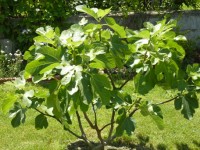| Pastilière |

In 1895, Simon-Louis Frères indicates that this fig tree was brought by a botanist named M. de Sieboldi, during his expedition in Japan to study the flora, between 1823 and 1830. In 1845, the Italian Gasparrini names this fig tree 'Hirta del Giappone' (of Japan), because of the small downy fuzz on fruits and leaves, but also because of the oriental origin.
Pastilière was described in California in 1860, with no indication of origin, but in 1888 Eisen declares that it originates from Italy. It is only in 1920 that it is clearly confirmed that Pastilière is identical to the 'Hirta du Japon' variety. The origin of this fig tree remains doubtful, because if this variety originates from Japan, then it could have been introduced in 1690 by the Portuguese. Nowadays, this variety is really spread in the region of Toulouse and seems completely absent from Italy. Pastilière is a tree of little vigor, of small size, adapted to small gardens, whose branches of medium caliber are covered by beautiful and dense foliage, slightly downy. The resistance to cold is excellent and is probably also increased by the lack of vigor of the new growth in Spring and the fast hardening of its wood in Summer. In addition the terminal buds which are normally very cold sensitive, resist to Winter without being damaged by frost. Early in Spring, this fig tree develops a lot of breba fruits that will rapidly fall at various growing phases. This tree is particularly interesting for the early and abundant main crop production. The fruits are really beautiful, initially blue, then dark black, of medium size, slightly downy. However, they tend to split easily, even in dry weather condition, as a consequence, they quickly spoil. They usually never dry on the tree and fall as soon as they are ripe. This fig is particularly juicy, pleasant, but may be disappointing, because of insufficient sugar rate. In addition, when summers are rainy and cool, the entire main crop production may fall. This behavior is usually observed in Spring, on many breba croppers, when temperatures greatly vary, but very rarely on main crop production. However, it is easy to plant this fig tree on a south-facing wall to limit wind impacts, temperatures changes… and fruits drop. Despite the relative growing difficulties, this fig tree remains interesting for the little place that it requires, the great cold resistance and the abundant and early main crop. In the family yard, when Pastilière is associated with other fig trees that produce breba fruits (Valleiry, Desert King or Grise de St-Jean) and main crop fruits (Dalmatie or Vallecalda ), it almost guarantees a continuous production between the last breba and the first main crop fruit. Finally, in cold years, this type of early fig tree usually enables a main crop. |
| General data | |
| Origin | France |
| Synonym(s), local names | Pastellère, Hirta du Japon, Hirta del Giappone, Rouge de Bordeaux |
| Tree type | Common |
| Crop | Uniferous |
| Tree morphological characteristics | |
| Shape | Erected |
| Vigor | Medium |
| Ability to produce suckers | Weak |
| Height after 10 years | 300 cm |
| Width after 10 years | 300 cm |
| Minimum width | 300 cm |
| Branch morphological characteristics | |
| Branch color | Brown black |
| Caliber | Large |
| Buds | Light green |
| Leaves morphological characteristics | |
| Leaves | Average |
| Lobs | 3-5 |
| Depth | Medium sinuses |
| Adaptation outside the Mediterranean area | |
| Cold hardiness | Excellent |
| Wind resistant | Very good |
| Pot culture | Good |


| Main crop |
| Yield | Strong |
| Fruits dropping | High fruit drop |
| Alternance | Strong |
| Sensitivity to splitting | Not resistant |
| Crop begin date (day-month) | Valleiry:12-09 |
| External characteristics | |
| Skin color | Blue, black |
| Skin thickness | Thick |
| Shape | Pyriform |
| Stalk | Breaks off readily |
| Stalk shape | Medium length and width |
| Neck | Short |
| Neck color | Dark pink |
| Eye | Medium, opened |
| Eye color | Blue, black |
| Average weight (grams) | 50 g |
| Internal characteristics | |
| Pulp color | Dark red |
| Seeds | Not felt |
| Organoleptic evaluation | |
| Texture | Very juicy |
| Sugar | Little sugar |
| Taste | Medium |
| Perfume | Weak |
| Organoleptic descriptors | Fruity |



